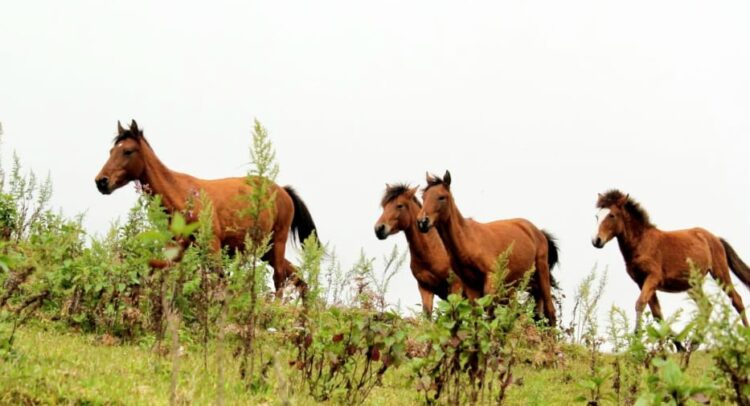
Asem Bhakta Singh, Special Correspondent North East
Imphal: (Waari Singbul Network) In a distressing revelation, reports from the Livestock Census conducted by the Government of Manipur disclose a disheartening statistic – 129 polo ponies have succumbed in the past 16 years, leaving only 1089 of the original breeds in the state. Despite concerted efforts by the state government to conserve these iconic animals, the population continues to dwindle, posing grave challenges for the struggling pony owners.
The Polo Pony, a diminutive yet robust breed, holds special significance as the backbone of the modern sport of Polo, originating right here in Manipur. Ironically, the very ponies that are a source of pride for the locals are inching towards extinction, with an annual decline of at least 8 ponies according to livestock census data.
Thangjam Basanta, a proud owner of 15 Polo Ponies, laments the rapid decline, attributing it to a multitude of factors, with the diminishing grazing grounds being the most critical. “Where should one feed the ponies? There are no grazing grounds left as they are encroached upon by humans for so-called developmental projects,” says Basanta, an avid polo player himself.
Contrary to the perception of Polo being a rich man’s sport elsewhere, in Manipur, it is predominantly played by commoners, often from economically challenged backgrounds. Most pony owners face substantial financial burdens, exacerbated by the absence of government schemes to aid in their upkeep.
“Revival of grazing and polo grounds is urgently needed to save the Polo and the Pony culture,” emphasizes Sarangthem Abung, a pony owner from Imphal West District, stressing the importance of government incentives for pony owners.
The iconic Hapta Kangjeibung, once a polo race course and practice ground, has been inaccessible to polo players since 2011, converted into a mela ground and used for political meetings. Basanta and Abung advocate for its restoration as a practicing ground to rejuvenate the diminishing polo culture.
Laisangbam Tomba of Moirang contemplates selling his four ponies to alleviate financial strain, reflecting the harsh reality faced by many owners. The absence of government incentives compounds the financial challenges, covering expenses for treatment, fodder, and stable maintenance.
Doren Singh, a skilled polo player and owner of 13 ponies, asserts that any conservation policy must address the dearth of grazing and polo practice grounds. He calls for government incentives for individual pony owners, akin to those provided to polo clubs.
There are around 26 Polo Clubs in the state.
The Manipur Horse Riding and Polo Association, established in 2005 with 34 ponies also functioning as a breeding farm for ponies, appreciates the government’s allocation to the association the 32 acres of land to be developed as grazing ground at Lamphelpat in 2022. However, Secretary Kongbrailatpam Dhanachandra Sharma stresses the need for more areas to be declared as pony reserves for grazing ground.
The Pony farm has 152 Ponies as of July 2023 and is being run by funds from individual members and fee incentives from the government.
Since the declaration of ponies as an endangered species in 2013, the numbers have plummeted from around 1000 in 2007 to the current 1089, as per the recent Livestock Census. Dr. R.K. Khogendra Singh, the Joint director of the Directorate of Veterinary and Animal Husbandry, government of Manipur attributes the decline to the underutilization of ponies.
In 2007, the number of Ponies in the Tingkai Khunou breeding farm numbered only 13. The Tingkai Khunou, located in Bishnupur District was established during 1985-86 as a Pony farm for conserving the Ponies.
To uplift the status of polo ponies, the Manipur government introduced the “Manipur Pony Conservation and Development Policy” in 2016, offering incentives to polo clubs. Dr. Khogendra emphasizes that full awareness, starting from grassroots levels, is imperative for pony conservation.
“Preserving the Manipuri Pony is not solely the obligation of the department; it is a collective responsibility. Comprehensive awareness needs to be instilled from the grassroots level by incorporating the pony’s narrative into the school curriculum,” asserted the joint director who continued, ”The department’s role primarily involves providing medical care, engaging in breeding activities to augment the population.” Dr. Khogendra clarified that the department bears no responsibility for animals succumbing to injuries on roads – these falls squarely on the Municipality and the respective owners.
The 20th livestock census recently conducted by the Veterinary Department revealed disheartening figures. Dr. R.K. Khogendra expressed his dismay, citing the district-wise breakdown of pony numbers: Bishnupur 97, Chandel 14, Churachandpur 59, Imphal East 266, Imphal West 619, Senapati 4, Tamenglong 75, Thoubal 53, and Ukhrul 2. Currently, the total population of ponies in the state is reported to be 1089.
As per an informed source, the livestock census in 2007 disclosed district-wise pony numbers: Bishnupur 115, Chandel 64, Churachandpur 85, Imphal East 35, Imphal West 302, Senapati 229, Tamenglong 54, Thoubal 280, and Ukhrul 54. At that time, the overall count of ponies in the state amounted to 1218.
Despite the efforts of the Manipur Police Department proposing a mounted unit in every police station to increase pony numbers, progress has been hindered due to the prevailing situation in Manipur, lamented, the Inspector General of Police Administration, IGP (Adm) K. Jayenta Singh. He added that the proposal envisions utilizing “Sagol Police” for law enforcement activities, emphasizing the multifaceted benefits of these equine allies.
As Manipur’s original polo ponies teeter on the brink of extinction, the urgency to address the challenges faced by individual pony owners and revive grazing and polo grounds becomes paramount for the preservation of this cultural and sporting heritage.
Among the northeastern states, Manipur stands as the only state possessing its distinct and pure horse breed. The Manipuri Pony is acknowledged as one of the five indigenous equine breeds in India, alongside Marwari, Kathiawari, Zanskari, and Spiti.


